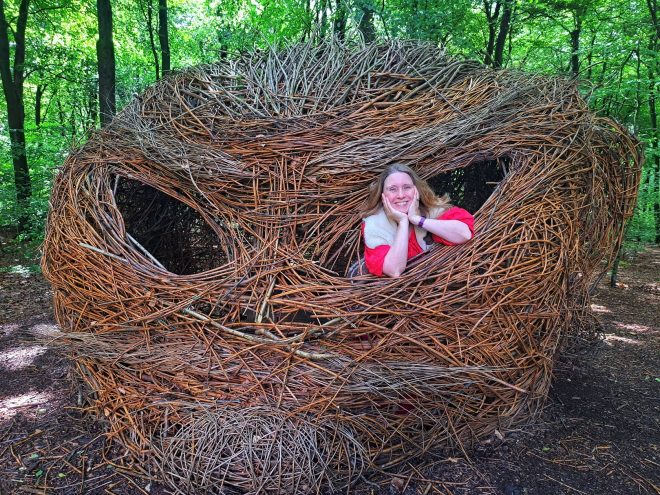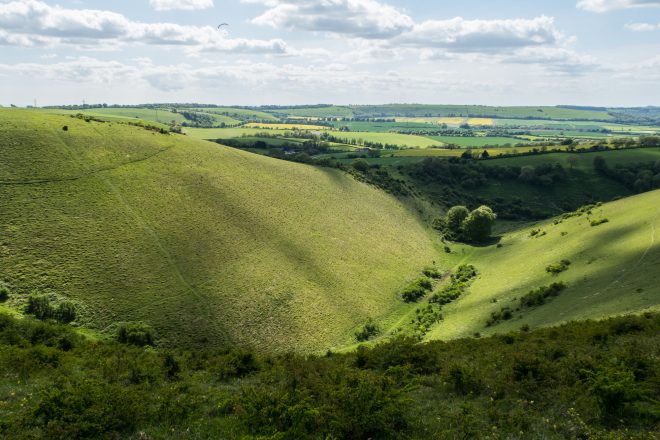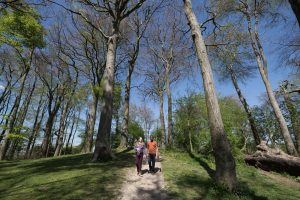South Downs folklore: Celebrating weird and wonderful tales from Hampshire
July 10, 2023

Halcyon Hampshire…a land of emerald hills, scenic harbours, crystal-clear chalk streams, leafy market towns and two of Britain’s most important maritime cities.
Hampshire makes up a third of the South Downs National Park and many would agree the western end of the Downs has a very different feel to its eastern end. This is a land of steep wooded hills. royal forests, purple heathlands, hop gardens, and hidden valleys.
Today you don’t have to step far from the hustle and bustle of urban life in Southampton and Portsmouth to escape to the beautiful tranquility and rich heritage of the South Downs National Park.
It’s an area inhabited by humans as far back as 4,000 BCE and has some of the best examples of Iron Age forts, such as Old Winchester Hill.
It’s not surprising therefore that this ancient land – which was the seat of the Kingdom of Wessex that later grew into present-day England – is a treasure trove of spellbinding folk tales and myths.
For Hampshire Day on 15 July, Dawn Nelson, a storyteller and interpretation officer for the National Park, shares three of her favourite folklore.
Dawn says: “Hampshire is such an important part of the National Park and very much has its own unique charm and landscape features. It includes the highest point in the ancient chalk ridge of the South Downs, Butser Hill, which stands 271m and offers some breathtaking views.

“The 15th of July is also known as St Swithin’s Day. St Swithin was the Bishop of Winchester in the mid-800s and the legend goes that on 15th July, St Swithin would stand on Old Winchester Bridge and should it rain then there would be rain for 40 days thereafter. Should it be sunny then there would be sun for 40 days. We shall have to see what St Swithin’s Day brings this!”
Dawn recorded her stories at the Giant’s Head in Queen Elizabeth Country Park, between Waterlooville and Petersfield. The elaborate sculpture, constructed by internationally-acclaimed artist Mark Antony Haden Ford, pays homage to the menacing Hampshire giant Ascapart.
The Betrayal Of Sir Bevis
The mythology of Britain tells us that many thousands of years ago this land was created by giants. They forged new paths and riverbeds, and shaped the cliffs, mountains and valleys. Over time these giants have been referred to by many different names and one of the giants thought to be responsible for forming the landscape here in Hampshire was called Ascapart. Ascapart was a small giants compared to those of his day and stood a mere 30 foot tall. Nevertheless, Ascapart was more than capable of terrifying the local villages around Southampton.
 When Sir Bevis and his horse Hirundelle returned from their travels, Bevis heard of this terrible being and sought to rid the area of this menace. Sir Bevis was a skilled knight with a swift horse, as its name suggests, and he quickly overcame the giant Ascapart. The only reason Ascapart lived, some say, was because Josain, Bevis’ wife persuaded Bevis to spare Ascapart’s life.
When Sir Bevis and his horse Hirundelle returned from their travels, Bevis heard of this terrible being and sought to rid the area of this menace. Sir Bevis was a skilled knight with a swift horse, as its name suggests, and he quickly overcame the giant Ascapart. The only reason Ascapart lived, some say, was because Josain, Bevis’ wife persuaded Bevis to spare Ascapart’s life.
Sir Bevis worried that the giant would eventually betray them but he respected his wife’s wishes and, in exchange for his life, Ascapart served Bevis. In a twist to the tale, some records recall that Ascapart did indeed betray Bevis and kidnapped Bevis’ wife holding her prisoner. For that Ascapart met his death at the hands of Bevis’ supporters and where he fell, his body became a part of the Downs.
Countless Stones
Stone circles are a unique feature of the British landscape and there are over 1000 in Britain, many of them much further north than the South Downs but there are still some to be found in the downland of Hampshire. Ancient and without a definitive explanation as to why they were built, stone circles have given rise to many stories and local legends.
At Bramdean, beside the A272, there is a stone circle that is thought to be one of those that you simply cannot count. Try as you might you will not get the same number of stones each time you try. This motif is known as countless stones. The circle is thought to have been built at some point in the 1800s, as a monument to a horse that once belonged to Colonel George Greenwood. Other legends tell of how it is the resting place of those soldiers that died in the battle of Cheriton in 1644.
Across the country there are tales of countless stones and what will happen if you do indeed manage to count them. You may raise the devil, you may lift a curse or who knows, in this case, you may get to meet Colonel Greenwood’s horse.
King Beneath The Hill
Some stories tell us that St Catherine’s Hill, just outside Winchester is the Ancient burial ground of King Arthur and if you care to look, the hilltop resembles a sleeping dragon. Furthermore the 13th century round table at which King Arthur and his Knights are said to have sat, hangs in The Great Hall at Winchester
 The barrow that is St Catherine’s Hill is associated with the legend of the King Under The Hill. This tale tells of a sleeping king beneath the barrow who is surrounded by all his knights and a vast amount of treasure too. Within the barrow there is a bell and if this bell is rung then the King, in this case King Arthur, will awake and once more, he and his knight’s will defend the land from enemy attack. Over the years some have tried to retrieve the treasure that is beneath the hill but the King guards it ferociously and this has never ended well for the would be treasure hunter. It is most definitely better to leave the king beneath the hill to sleep until such days as we may need him.
The barrow that is St Catherine’s Hill is associated with the legend of the King Under The Hill. This tale tells of a sleeping king beneath the barrow who is surrounded by all his knights and a vast amount of treasure too. Within the barrow there is a bell and if this bell is rung then the King, in this case King Arthur, will awake and once more, he and his knight’s will defend the land from enemy attack. Over the years some have tried to retrieve the treasure that is beneath the hill but the King guards it ferociously and this has never ended well for the would be treasure hunter. It is most definitely better to leave the king beneath the hill to sleep until such days as we may need him.
